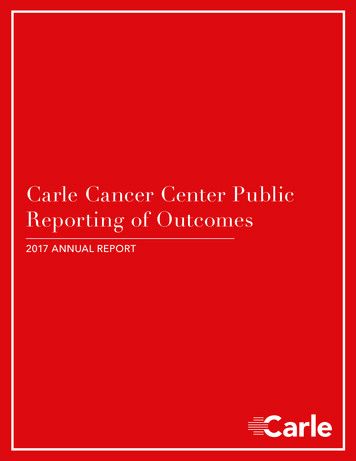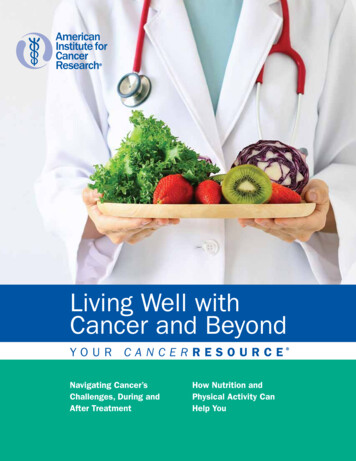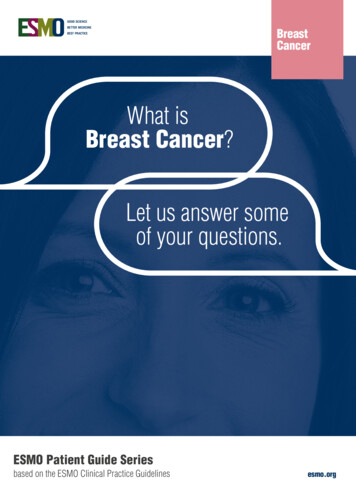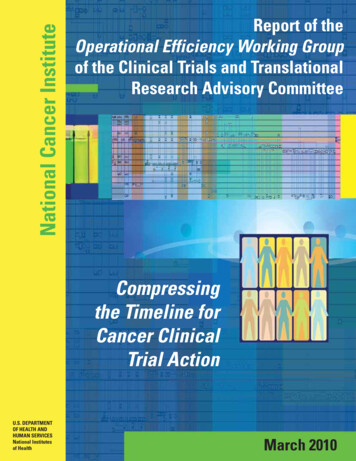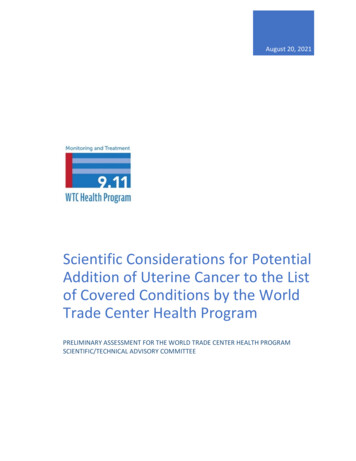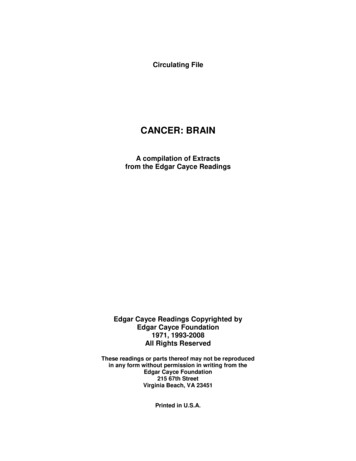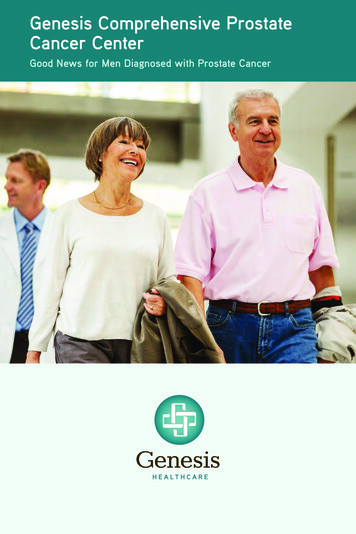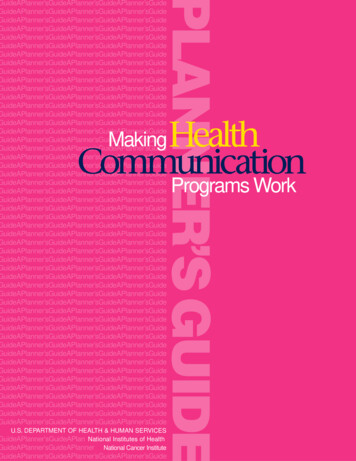
Transcription
PLANNER’S GuideU.S. DEPARTMENT OF HEALTH & HUMAN anner’sGuideNational Institutes of HealthGuideAPlanner’sGuideAPlanAPuideNational Cancer rams Work
HealthCommunicationMakingPrograms WorkU.S. DEPARTMENT OF HEALTH & HUMAN SERVICESPublic Health Service National Institutes of HealthNational Cancer Institute
��sGuideAPlanner’sGuideAPlanner’sGuide
PrefaceThis book is a revision of the original Making HealthCommunication Programs Work, first printed in 1989, whichthe Office of Cancer Communications (OCC, now the Officeof Communications) of the National Cancer Institute (NCI)developed to guide communication program planning. During the 25years that NCI has been involved in health communication, ongoingevaluation of our communication programs has affirmed the value ofusing specific communication strategies to promote health and preventdisease. Research and practice continue to expand our understandingof the principles, theories, and techniques that provide a soundfoundation for successful health communication programs. The purposeof this revision is to update communication planning guidelines toaccount for the advances in knowledge and technology that haveoccurred during the past decade.To prepare this update, NCI solicited ideas and information fromvarious health communication program planners and experts (seeAcknowledgments). Their contributions ranged from reviewing andcommenting on existing text to providing real-life examples to illustratekey concepts. In addition, the Centers for Disease Control andPrevention (CDC) provided extensive input as part of the agency’spartnership with NCI.Although communicating effectively about health is an exacting task,those who have the earlier version of this publication know that it ispossible. We hope the ideas and information in this revision will helpnew health communication programs start soundly and matureprograms work even better.
AcknowledgmentsMany health communication experts contributed to the revision of this book.For their invaluable input, we would like to thank:Elaine Bratic ArkinCynthia Bauer, Ph.D.John BurklowLynne DonerTimothy Edgar, Ph.D.Brian R. FlayHealth Communications ConsultantU.S. Department of Health andHuman ServicesOffice of Communication and Public LiaisonNational Institutes of HealthHealth Communications ConsultantWestatUniversity of Illinois at ChicagoVicki S. Freimuth, Ph.D.Office of CommunicationCenters for Disease Control and PreventionJoanne Gallivan, M.S., R.D.National Institute of Diabetes and Digestiveand Kidney DiseasesKaren Glanz, Ph.D., M.P.H.Cancer Research Center of HawaiiBernard Glassman, M.A.T.Special Expert in InformaticsNational Cancer InstituteSusan HagerJane Lewis, Dr.P.H.Terry LongHager SharpUMDNJ, School of Public HealthNational Heart, Lung, and Blood Institute
Kathleen Loughrey, M.S., R.D.Health Communications ConsultantSusan K. Maloney, M.H.S.Health Communications ConsultantJoy R. Mara, M.A.John McGrathDiane Miller, M.P.A.Ken Rabin, Ph.D.Scott C. Ratzan, M.D., M.P.A.Barbara K. Rimer, Dr.P.H.Victor J. Strecher, Ph.D., M.P.H.Tim L. Tinker, Dr.P.H., M.P.H.Joy R. Mara CommunicationsNational Institute of Child Health andHuman DevelopmentNational Institute on Alcohol Abuse andAlcoholismRuder Finn Healthcare, Inc.Journal of Health CommunicationU.S. Agency for International DevelopmentDivision of Cancer Control andPopulation SciencesNational Cancer InstituteUniversity of MichiganWidmeyer CommunicationsWe would especially like to thank Elaine Bratic Arkin, author of the original book, whose knowledge ofhealth communication program planning made this revision possible, as well as Lynne Doner, whosebroad-based consumer research and evaluation expertise has enhanced the book’s content and quality.Both have provided hours of review and consultation, and we are grateful to them for their contributions.Thanks to the staff of the Office of Communications, particularly Nelvis Castro, Ellen Eisner, and AnneLubenow. And thanks to Christine Theisen, who coordinated the revisions to the original text.This document was revised in coordination with the Centers for Disease Control and Prevention duringdevelopment of CDCynergy—a program-planning tool on CD-ROM.
Table of ContentsWhy Should You Use This Book?iIntroduction1The Role of Health Communication in Disease Prevention and ControlWhat Health Communication Can and Cannot DoPlanning Frameworks, Theories, and Models of ChangeHow Market Research and Evaluation Fit Into Communication ProgramsSelected Readings23789Overview: The Health Communication Process11The Stages of the Health Communication Process11Stage 1: Planning and Strategy Development15Why Planning Is ImportantPlanning StepsCommon Myths and Misconceptions About PlanningSelected Readings16164850Stage 2: Developing and Pretesting Concepts,Messages, and Materials53Why Developing and Pretesting Messages and Materials Are ImportantSteps in Developing and Pretesting Messages and MaterialsPlanning for Production, Distribution, Promotion, and Process EvaluationCommon Myths and Misconceptions About Materials PretestingSelected Readings5454868687Stage 3: Implementing the Program91Preparing to Implement Your ProgramMaintaining Media Relations After LaunchWorking With the Media During a Crisis SituationManaging Implementation: Monitoring and Problem SolvingMaintaining PartnershipsCommon Myths and Misconceptions About Program ImplementationSelected Readings92959898102103104
Stage 4: Assessing Effectiveness andMaking Refinements107Why Outcome Evaluation Is ImportantRevising the Outcome Evaluation PlanConducting Outcome EvaluationRefining Your Health Communication ProgramCommon Myths and Misconceptions About EvaluationSelected Readings108108110121121123Communication Research Methods125Types of Communication ResearchDifferences Between Qualitative and Quantitative Research MethodsQualitative Research MethodsQuasi-Quantitative Research Methods: Pretesting Messages and MaterialsQuantitative Research MethodsAdditional Research Methods126126127141157161Appendix A: Communication PlanningForms and Samples169Appendix B: Selected Planning Frameworks, SocialScience Theories, and Models of Change217Appendix C: Information Sources229Appendix D: Selected Readings and Resources235Appendix E: Glossary245
��sGuideAPlanner’sGuideAPlanner’sGuide
Why Should You Use This Book?The planning steps in this book can help make anycommunication program work, regardless of size, topic,geographic span, intended audience, or budget. (intendedaudience is the term this book uses to convey what otherpublications may refer to as a target audience.) The key is reading allthe steps and adapting those relevant to your program at a level ofeffort appropriate to the program’s scope. The tips and sidebarsthroughout the book suggest ways to tailor the process to yourvarious communication needs.If you have limited funding, you might Work with partners who can add their resources to your ownConduct activities on a smaller scaleUse volunteer assistanceSeek out existing information and approaches developed byprograms that have addressed similar issues to reducedevelopmental costsDon’t let budget constraints keep you from setting objectives, learningabout your intended audience, or pretesting. Neglecting any of thesesteps could limit your program’s effectiveness before it starts.This book describes a practical approach for planning andimplementing health communication efforts; it offers guidelines, nothard and fast rules. Your situation may not permit or require each stepoutlined in the following chapters, but we hope you will consider eachguideline and decide carefully whether it applies to your situation.To request additional copies of this book, please visit NCI’s Web siteat www.cancer.gov or call NCI’s Cancer Information Service at1-800-4-CANCER (1-800-422-6237).
’sGuideAPlanner’sGuide
In This Section: The role of health communication in disease prevention and control What health communication can and cannot do Planning frameworks, theories, and models of change How research and evaluation fit into communication programsQuestions to Ask and Answer: Can communication help us achieve all or some of our aims? How can health communication fit into our program? What theories, models, and practices should we use to planour communication program? What types of evaluation should we include?INTROIntroduction
The Role of Health Communication inDisease Prevention and Controlproducts and determine the channels thatdeliver them to the right intended audiences.There are numerous definitions of healthcommunication. The National CancerInstitute and the Centers for Disease Controland Prevention use the following:Since this book first appeared in 1989,the discipline of health communication hasgrown and matured. As research hascontinued to validate and define theeffectiveness of health communication, thisbook has become a widely accepted toolfor promoting public health. Healthy People2010, the U.S. Department of Health andHuman Services’ stated health objectives forthe nation, contains separate objectives forhealth communication for the first time.Meanwhile, the availability of newtechnologies is expanding access tohealth information and raising questionsabout equality of access, accuracy ofinformation, and how to use the new toolsmost effectively.The study and use of communicationstrategies to inform and influenceindividual and community decisionsthat enhance health.Use the principles of effective healthcommunication to plan and create initiativesat all levels, from one brochure or Web siteto a complete communication campaign.Successful health communication programsinvolve more than the production ofmessages and materials. They useresearch-based strategies to shape the2
Understanding what health communicationcan and cannot do is critical tocommunicating successfully. Healthcommunication is one tool for promoting orimproving health. Changes in health careservices, technology, regulations, and policyare often also necessary to completelyaddress a health problem.Communication alone can: Produce sustained change in complexhealth behaviors without the support of alarger program for change, includingcomponents addressing health careservices, technology, and changes inregulations and policy Be equally effective in addressing allissues or relaying all messages becausethe topic or suggested behavior changemay be complex, because the intendedaudience may have preconceptions aboutthe topic or message sender, or becausethe topic may be controversialCommunication Can Affect MultipleTypes of Change Increase the intended audience’sknowledge and awareness of a healthissue, problem, or solution Influence perceptions, beliefs, andattitudes that may change social norms Prompt action Demonstrate or illustrate healthy skills Reinforce knowledge, attitudes,or behavior Show the benefit of behavior change Advocate a position on a health issueor policy Increase demand or support forhealth services Refute myths and misconceptions Strengthen organizational relationshipsHealth communication programs canaffect change among individuals and alsoin organizations, communities, and societyas a whole:Communication combined with otherstrategies can: Cause sustained change in which anindividual adopts and maintains a newhealth behavior or an organization adoptsand maintains a new policy direction Overcome barriers/systemic problems,such as insufficient access to careCommunication cannot: Compensate for inadequate health care oraccess to health care services Individuals—The interpersonal level is themost fundamental level of health-relatedcommunication because individualbehavior affects health status.Communication can affect individuals’awareness, knowledge, attitudes, selfefficacy, skills, and commitment tobehavior change. Activities directed atother intended audiences for change mayalso affect individual change, such asinvolving patients in their own care. Groups—The informal groups to whichpeople belong and the community settingsthey frequent can have a significantimpact on their health. Examples includerelationships between customers andemployees at a salon or restaurant,exercisers who go to the same gym,students and parents in a school setting,employees at a worksite, and patients andhealth professionals at a clinic. Activitiesaimed at this level can take advantage ofthese informal settings.Making Health Communication Programs Work3INTROWhat Health Communication Canand Cannot Do
Organizations—Organizations are groupswith defined structures, such asassociations, clubs, or civic groups. Thiscategory can also include businesses,government agencies, and health insurers.Organizations can carry health messagesto their constituents, provide support forhealth communication programs, andmake policy changes that encourageindividual change. Communities—Community opinionleaders and policymakers can be effectiveallies in influencing change in policies,products, and services that can hinder orsupport people’s actions. By influencingcommunities, health communicationprograms can promote increasedawareness of an issue, changes inattitudes and beliefs, and group orinstitutional support for desirablebehaviors. In addition, communicationcan advocate policy or structural changesin the community (e.g., sidewalks) thatencourage healthy behavior. Society—Society as a whole influencesindividual behavior by affecting norms andvalues, attitudes and opinions, laws andpolicies, and by creating physical,economic, cultural, and informationenvironments. Health communicationprograms aimed at the societal level canchange individual attitudes or behaviorand thus change social norms. Effortsto reduce drunk driving, for example,have changed individual and societalattitudes, behaviors, and policies throughmultiple forms of intervention,including communication.Multistrategy health communicationprograms can address one or all ofthe above.4IntroductionCommunication Programs Can IncludeMultiple Methods of InfluenceHealth communicators can use a wide rangeof methods to design programs tofit specific circumstances. Thesemethods include: Media literacy—teaches intendedaudiences (often youth) to deconstructmedia messages so they can identify thesponsor’s motives; also teachescommunicators how to composemessages attuned to the intendedaudience’s point of view Media advocacy—seeks to change thesocial and political environment in whichdecisions that affect health and healthresources are made by influencing themass media’s selection of topics and byshaping the debate about those topics Public relations—promotes the inclusionof messages about a health issue orbehavior in the mass media Advertising—places paid or public servicemessages in the media or in public spacesto increase awareness of and support fora product, service, or behavior Education entertainment—seeks toembed health-promoting messages andstorylines into entertainment and newsprograms or to eliminate messages thatcounter health messages; can also includeseeking entertainment industry support fora health issue Individual and group instruction—influences, counsels, and provides skills tosupport desirable behaviors Partnership development—increasessupport for a program or issue byharnessing the influence, credibility, andresources of profit, nonprofit, orgovernmental organizations
INTROCHARACTERISTICS OF EFFECTIVE HEALTH COMMUNICATION CAMPAIGNSCertain attributes can make health communication campaigns more effective.Use the guidelines in this section to plan your campaign.Define the communication campaign goal effectively: Identify the larger goal Determine which part of the larger goal could be met by a communication campaign Describe the specific objectives of the campaign; integrate these into a campaign planDefine the intended audience effectively: Identify the group to whom you want to communicate your message Consider identifying subgroups to whom you could tailor your message Learn as much as possible about the intended audience; add information about beliefs,current actions, and social and physical environment to demographic informationCreate messages effectively: Brainstorm messages that fit with the communication campaign goal and theintended audience(s) Identify channels and sources that are considered credible and influential by theintended audience(s) Consider the best times to reach the audience(s) and prepare messages accordingly Select a few messages and plan to pretest themPretest and revise messages and materials effectively: Select pretesting methods that fit the campaign’s budget and timeline Pretest messages and materials with people who share the attributes of theintended audience(s) Take the time to revise messages and materials based upon pretesting findingsImplement the campaign effectively: Follow the plans you developed at the beginning of the campaign Communicate with partners and the media as necessary to ensure the campaignruns smoothly Begin evaluating the campaign plan and processes as soon as the campaignis implementedNote. Adapted from the University of Kansas Community Toolbox, CommunityWorkstation, available at /outline.htm.Accessed March 7, 2002.Making Health Communication Programs Work5
THEORIES GUIDE ACTION TO INCREASE MAMMOGRAPHY USEFox Chase Cancer Center, in cooperation with area managed care organizations, designeda program that was based on key elements of the health belief model to encourage womento have regular mammograms. Selected women received educational materials explainingthat virtually all women are at risk for breast cancer, regardless of the absence ofsymptoms, and that risk increases with age (susceptibility). The materials stressed thatearly detection brings not only the best chance of cure but also the widest range oftreatment choices (benefit). Women received a letter stating their physician’s support (cueto action) and a coupon for a free mammogram (to overcome the cost barrier). Those whodid not have a mammogram within 90 days received different forms of reminders (cues toaction). In the most intensive reminder, a telephone counselor called selected women toreview their perceptions about susceptibility, benefits, and barriers. Program evaluationshowed that mammography use increased substantially.The Fox Chase program also applied social learning theory in developing interventions toencourage physician support of mammography and to improve clinical breastexaminations (CBEs). The planners examined the environmental and situational factorsthat might affect physician behavior and tried to change the low expectations ofphysicians about the benefits of breast screening. The interventions includedobservational learning by watching an expert perform a CBE, an opportunity to increaseself-efficacy by practicing CBE with the instructor, and the use of a feedback report andCME credits to reinforce physician skills.In taking a community approach to change, a UCLA mammography program used adiffusion of innovations model. Community analysis showed that women who were earlyadopters (leaders) already had a heightened awareness of the value of mammography. Toreach middle adopters, the program mobilized the social influence of the early adopters byusing volunteers who had breast cancer to provide mammography information. Theprog
health communication program planning made this revision possible, as well as Lynne Doner, whose broad-based consumer research and evaluation expertise has enhanced the book’s content and quality. Both have provided hours of review and consultat


